Seven years on
Posted: 11 March 2013 20:12
This week marks the seventh anniversary of The Defence of East Sussex Project and another year of progress!
It has only been another twelve months, but things continue to push on; looking back at last year's reflective piece, I see that things haven't gone quite according to the plan.
The bad news
Firstly, nothing has changed on the book-writing front in the past year and this has mostly been down to the mission creep I described last year. However, I have been procrastinating on this. My fifth anniversary piece predicted publication of my first book by 2012. I have decided to avoid all predictions of getting started, never mind actually getting published...
Secondly, blog writing has been patchy, emails have stacked up and I've still not got to grips with Twitter to the degree or frequency that I would have liked.
Archive research
It's not all been bad news though; in the previous 12 months I've been to The National Archives a staggering 30 times - by far the most in any year to date. 18 visits in the last five months alone pushed my documentary research forward by about two years!
In total, I've undertaken 89 visits,and drawn a total of 1,761 files. I will predict reaching my century of visits before next year though!
Fieldwork
I've done some interesting projects of late; most notable of them perhaps investigating bomb craters. Recording the damage at Eastbourne's Ocklynge Cemetery and also at Hove Cemetery (photo below) are certainly highlights of this.
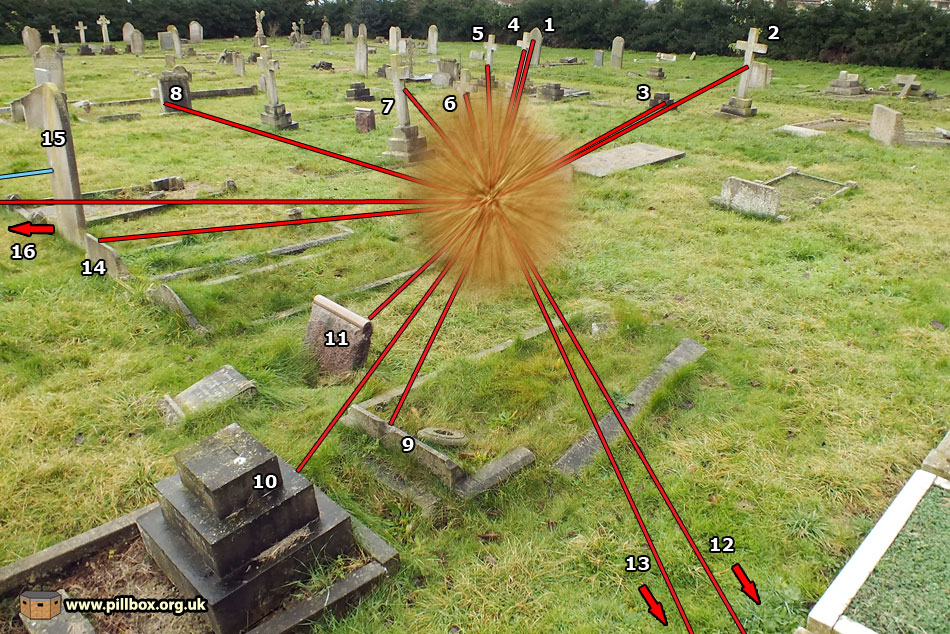
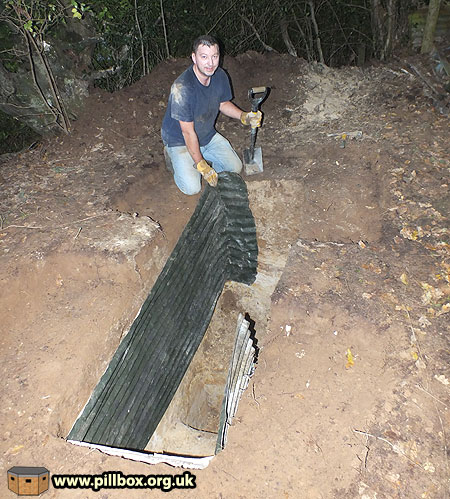
I've also been dabbling in experiential archaeology.
The photo at right shows a rather grubby historian in the process of digging a slit trench last summer.
This is part of a project I'm leading with Sussex Military History Society.
The trench is being dug according to contemporary manuals and it has been hard work!
I've learned a lot about the practicalities of constructing one of these, from siting and aligning through to the actual excavation and disposal of spoil.
The scavenging of improvised construction materials was also interesting!
The trench itself is not yet finished, but a full report and write-up on the full project is in the pipeline for later in the year.
On the subject of trenches and earthworks, I've been examining some anti-tank ditches; one predating and one postdating the invasion scares of 1940-41.
I've also stumbled upon a trench system in some woods, part of which is shown in the photo below. This is leading me to have to re-evaluate some aspects of the archaeological record on such matters. A dedicated post will hopefully follow on this.
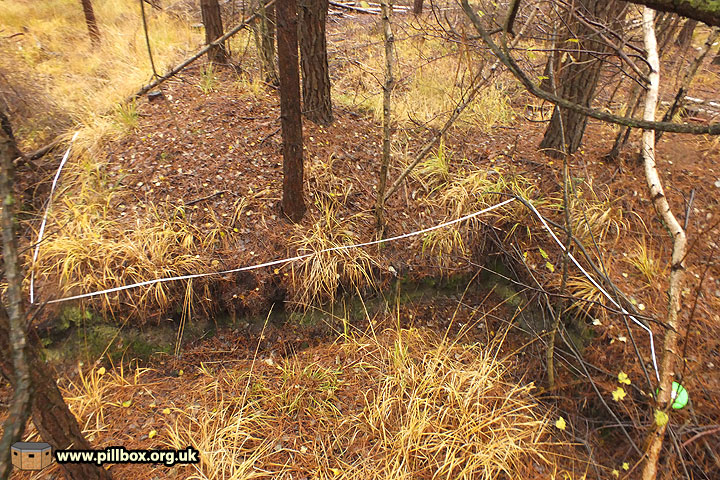
My fieldwork is still mostly document-lead; a war diary tells me that something was happening at a particular location and I turn up 70 years on and try and locate extant evidence. Last July I discovered perhaps the closest match between wartime documents and the 21st century landscape in my post on a bomb crater and mystery structure at Eastbourne. The graphic below is a cross-section of the scene.
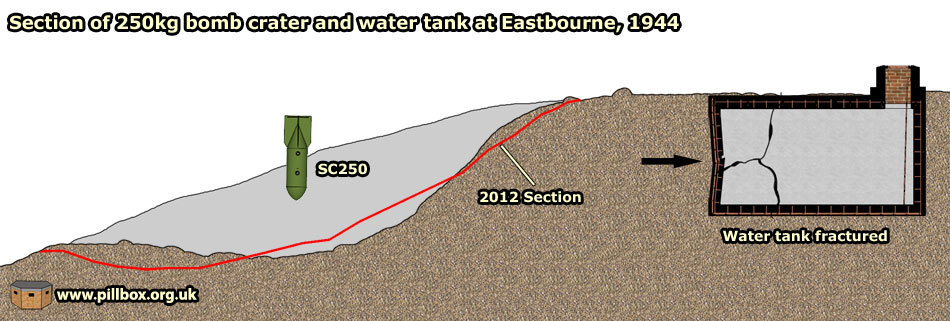
Databases
The Concrete Evidence database currently contains 4134 sites with 4506 functions - a total of 4949 features.
The stats have been boosted by the inclusion of 765 V1 impact sites; these have been imported from a separate database which I have compiled from a variety of primary documents.
However, there is a slight blockage in the pipeline in data from the documents being added to Concrete Evidence. Because of the sheer volume of data I've gathered, I need to ensure that a basic level of indexing is in place.
Any document/report/memo within each file needs to be individually indexed before it can be used as evidence for the existence of a defence work. My database rules mean that a new entry cannot be added to Concrete Evidence unless I can associate a specific source, i.e., the document needs to exist in the TNA database before I can do this.
Each individual document/report/memo also needs to be associated with the individual photograph of its first page; this means that each individual image needs to be added to a database. This currently contains nearly 70,000 photos, but I still have a backlog of an estimated 10,000 still to add, despite having an automated process that harvests the metadata from each folder. This will seem to be nerdy overkill, but once it's done, the benefits will be worth the effort!
Order of Battle database
Every file reference is added to my TNA database after each visit, but each file also needs to be associated with the unit/department that created it. This in turn means that I need to have my Order of Battle (ORBAT) database in order.
An ORBAT is the command structure and hierarchy of a military formation - you can think of it as a "team sheet". It is this that has occupied many hours of my time over the past year, as everything else hangs on this being in order.
I did start compiling my ORBAT quite early on in the project, but it soon got overwhelmed as mission creep set in. I had to reconstruct the ORBAT to encompass the ever-changing structure at multiple points in time and have only recently completed the basic structure. The graphic below shows one of my ORBAT screens (it's not publicly available, hence the basic design). The left column gives the broad structure down to battalion level, the centre column displays the detailed structure of the selected unit, with supporting notes and insignia on the right. Every piece of information I have about a unit links to this system, which is connected to the TNA database.
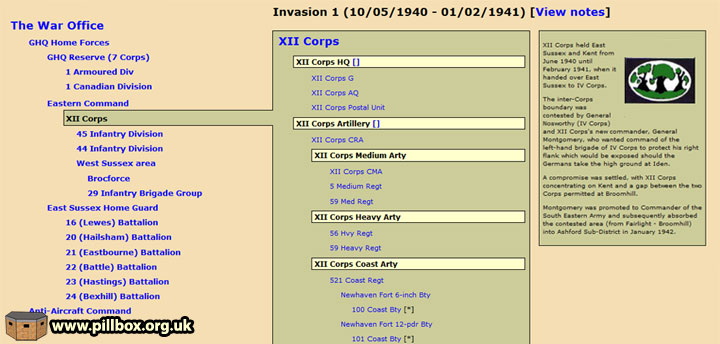
I've still got a lot to do, but this will also pay dividends by allowing me to more effectively target the files I need to access. Once this is completed, I will then be able to view the ORBAT at key points in time. For example, if an air raid is recorded in an infantry unit's records, I can quickly locate the anti-aircraft units who were in the area at the same time to cross-reference the incident.
The only problem is that I keep identifying extra formations whose records I need to access; I know of at least three armoured and four infantry divisions, with a lot of Anti-Aircraft Command files that I've yet to photograph!
In all, it's been a productive year!
- Pete

Email:
Blog Latest

Bishopstone reveals its pillbox secrets
18 October 2021

Pillbox or Observation Post?
10 June 2020

Uncovering the hidden secrets of a pillbox
8 June 2019

Review of 2018
31 December 2018

Wartime Christmas in East Sussex (2)
24 December 2018
Jargon-buster
Anti-tank ditch
Ditch designed to hinder movement of tanks and AFVs. Ditches could be entirely artificial or existing ditches or natural features such as rivers, might be dredged, shaped and revetted to improve their effectiveness.
Slit trench
Small, narrow trench designed to provide protection against shrapnel and other battlefield hazards. Technically distinct from a weapon pit (which was intended soley as a defensive position) slit trenches were also used as defence works.
TNA
The National Archives (formerly The Public Records Office or PRO).
War diary
A record of events kept by all units from the point of mobilisation. A diary's contents vary enormously from unit to unit; some give detailed entries by the hour on a daily basis while others merely summarise events on a weekly/monthly basis.
This site is copyright © Peter Hibbs 2006 - 2024. All rights reserved.
Hibbs, Peter Seven years on (2024) Available at: http://pillbox.org.uk/blog/216719/ Accessed: 27 July 2024
The information on this website is intended solely to describe the ongoing research activity of The Defence of East Sussex Project; it is not comprehensive or properly presented. It is therefore NOT suitable as a basis for producing derivative works or surveys!